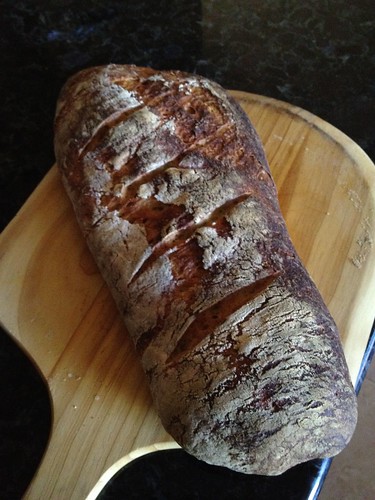Adventures in Sourdough
I’m a fan of rustic loaves – for the longest time I had been using this no-knead bread dough recipe – it’s a fantastic stand-by and I know it will turn out a wonderful loaf…but a while back, a friend of mine gave me a portion of her sourdough starter. Since all living things need a name, mine is named Eliza. She usually lives in the fridge in hibernation, but every now and again I fetch her out, pour off her hooch and prod her back to life. In preparation for Thanksgiving, I figured I should work on turning out some nice rustic sourdough bread.
Instead of following the king arthur recipe (where I learned all about the care and feeding of my starter), I opted to give another recipe a try – I was looking for something that didn’t require kneading – mostly because I hate dragging out my stand mixer and I wasn’t up for a vigorous kneading by hand. I wound up using quite a bit more water than what is called for in the recipe (an additional cup) to get the dough to pull together into a slack and shaggy dough. After reading through all the comments, I suspect 1) my starter is not fed at the same ratio that the author’s is and 2) the use of commercial flour rather than whole grain/home ground flour also greatly affected the water:flour ratio. Since I didn’t have any bread flour on hand, I also added a couple tablespoons of vital wheat gluten.
I suspect I may have been a bit hasty with the amount of water I added as the dough was still quite slack by the time I got all the flour incorporated. Sure enough, the dough was too wet to really support itself through the final rise – and I wound up with more of a ciabatta than a batard. Crumb was moist, with fairly uniform medium sized holes. I’ll be trying again this thanksgiving with less water next time 🙂
Recipe (as adapted from Nourished Kitchen):
Ingredients:
1 cup (about 8 ounces) vigorous and fed sourdough starter
3 1/2 cups unbleached all-purpose flour*
2 teaspoons sea salt
2 tablespoons vital wheat gluten
1 1/2 cups water
Method:
1) Mix all ingredients together well in a large container to form a shaggy dough.
2) Cover the container, and allow the dough to double in size – approximately 12 hours.
3) Scoop the dough out onto a work surface and fold it over on itself twice. Return it to its container and allow it double in size again – approximately 2 – 4 hours.
4) Turn the dough out onto a well floured work surface and shape it gently into your preferred shape. If desired, transfer the shaped dough onto a piece of parchment paper. Allow the dough to sit for its final rise to double in bulk again – approximately 2 hours
5) About an hour before you are ready to bake, place your baking stone on the middle rack of your oven, and place either a heavy cast iron pan or some other heavy pan (not glass or ceramic) on the bottom rack. Preheat the oven to 450.
6) once preheated, if you are not using parchment, sprinkle some semolina or coarse cornmeal on the baking stone before transferring the bread into the oven. Quickly give your loaf a few slashes with a sharp knife and transfer it onto the prepared baking stone. If you are using parchment, just transfer the dough on the parchment to the stone. Carefully pour a half-cup of water into the heavy pan in the bottom of the oven. Make sure not to drip on your glass oven window and be careful not to burn yourself with the hot pans, racks or steam! An alternate method that I have not tried is to pre-spritz the dough with water before slashing it and putting it in the oven (and skipping the whole pouring water into the bottom of the oven bit)
7) bake for 40-45 minutes or until a deep golden brown. I suspect the time could be reduced as far as 25-30 minutes based on some other bread recipes – the key is the internal temperature, which should register around 190°F on an instant read thermometer.
8) the hard part: Allow the loaf to cool completely before cutting it! This bread stores well cut-side down on the counter…but if yours tastes as good as mine, you won’t have to worry about storing it for long!
*I use a blend of unbleached-all-purpose flour and white whole wheat flour.
